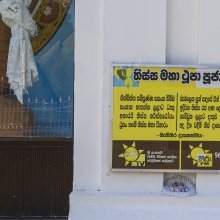Mahathupa, Mahāthūpa, Maha-thupa: 2 definitions
Introduction:
Mahathupa means something in Buddhism, Pali, the history of ancient India. If you want to know the exact meaning, history, etymology or English translation of this term then check out the descriptions on this page. Add your comment or reference to a book if you want to contribute to this summary article.
Images (photo gallery)
In Buddhism
Theravada (major branch of Buddhism)
Source: Pali Kanon: Pali Proper NamesThe great Thupa in Anuradhapura, built by Dutthagamani. The site on which it was erected was consecrated by the visit of all the four Buddhas of this kappa and was at the upper end of the Kakudhavapi. It was one of the spots at which Mahinda scattered campaka flowers by way of homage, and the earth trembled. When Mahinda informed Devanampiyatissa of the great sanctity of the spot and of its suitability for a Thupa, Tissa immediately wished to build the Thupa himself, but Mahinda bade him desist, telling him that the work would be carried out in the future by Dutthagamani. Tissa recorded this prophecy on a pillar of stone (Mhv.xv.51ff., 167ff). When Dutthagamani had won his victory over the Damilas and had brought peace to the country, he saw the prophecy inscribed on the stone pillar, but was unwilling to start the work as the people were too crippled with regard to money to be able to support such an immense undertaking. But the devas read his thoughts and provided him with all the necessaries for the building of the Thupa. Prepared bricks were found on the banks of the Gambhiranadi, copper near Tambapittha, silver in the Ambatthakolalena, pearls at Uruvela, and gems in a cave near Pelivapigama. The building was started on the full moon day of Visakha. The foundation stone was laid on the fourteenth day of the bright half of the month of Asalha. Great celebrations marked the event, arrangements for which were in the hands of the ministers Visakha and Sirideva. Monks were present not only from all over Ceylon but from many other places: eighty thousand under Indagutta from Rajagaha, twelve thousand under Dhammasena from Isipatana, sixty thousand under Piyadassi from Jetavanarama, eighteen thousand under Maha Buddharakkhita from Mahavana in Vesali, thirty thousand under Maha Dhammarakkhita from Ghositarama in Kosambi, forty thousand under Maha Sangharakkhita from Dakkhinagiri in Ujjeni, one hundred and sixty thousand under Mittinna Asokarama in Pataliputta, two hundred and eighty thousand under Uttinna from Kasmira, four hundred and sixty thousand under Mahadeva from Pallabhogga, thirty thousand under Yonamaha Dhammarakkhita from Alasanda, sixty thousand under Uttara from Vinjhatavi, thirty thousand under Cittagutta from Bodhimanda vihara, eighty thousand under Candagutta from Vanavasa, and ninety six thousand under Suriyagutta from Kelasa vihara. Of arahants alone ninety six crores were present.
As the king stepped into the space left open for him, he expressed the desire that, if his worship were to have a happy result, theras bearing the names of the Buddha, his Dhamma and his Sangha, should take their places on the east, south, and west sides respectively, and a thera bearing the name of Ananda on the north side, each thera to be surrounded by a group bearing the same name. The kings wish was fulfilled;
Theravāda is a major branch of Buddhism having the the Pali canon (tipitaka) as their canonical literature, which includes the vinaya-pitaka (monastic rules), the sutta-pitaka (Buddhist sermons) and the abhidhamma-pitaka (philosophy and psychology).
India history and geography
Source: archive.org: Ceylon Branch of the Royal Asiatic Society 19631) Mahāthūpa (Ruvanvālisāya) is the name of a thūpa at the Mahāvihāra in Anurādhapura.—The site is said to have been consecrated by the Buddha and to have been marked by an inscribed pillar set up by Devānaṃpiya Tissa (B.C. 247-207) at the upper end of the Kakudha pond. Duṭṭhagāmaṇi Abhaya built the Mahāthūpa (B.C. 137) but died before it was completed: Saddhātissa (B.C. 137-119) finished the work remaining to be done on the superstructure and the Elephant wall and completed the plastering. The Thūpa was 120 cubits (180 feet) high.
2) Mahāthūpa is the name of an ancient locality that once existed near Polonnaruva (Polonnaruwa), Ceylon (Sri Lanka).—To north of the Ālāhana Pariveṇa were:—(i) Uttarārāma, now called Galvihāra, built by Parakkamabāhu I by breaking down the rock near the Mahāthūpa or Damila Thūpa and constructing 3 caves, (a) the Vijjādhara cave, (b) the cave with the Sedent Image, and (c) the cave with the Recumbent Image. (ii) Mahāthūpa or Damila Thūpa, to build which Parakkamabāhu employed Damila prisoners-of-war: it was intended to be the largest thūpa in Ceylon, but the original plan was abandoned and a disproportionate dome was superimposed on the vast basal terraces: it is now known as Unagala-vehera.

The history of India traces the identification of countries, villages, towns and other regions of India, as well as mythology, zoology, royal dynasties, rulers, tribes, local festivities and traditions and regional languages. Ancient India enjoyed religious freedom and encourages the path of Dharma, a concept common to Buddhism, Hinduism, and Jainism.
See also (Relevant definitions)
Full-text (+88): Hemavalika Cetiya, Sonnamali, Mahacetiya, Hemamalaka, Suvannamali, Damilathupa, Acala, Ratanavaluka, Sirivadhaka, Mahamangala, Sirideva, Urucetiya, Uttinna, Silasobbhakandaka Cetiya, Sumanavapigama, Cetiyavamsatthakatha, Meghalata, Tambapittha, Mittinna, Katthahala-parivena.
Relevant text
Search found 5 books and stories containing Mahathupa, Mahāthūpa, Maha-thupa, Mahā-thūpa; (plurals include: Mahathupas, Mahāthūpas, thupas, thūpas). You can also click to the full overview containing English textual excerpts. Below are direct links for the most relevant articles:
Dipavamsa (study) (by Sibani Barman)
Vinaya Pitaka (3): Khandhaka (by I. B. Horner)
The story of the excellent group < [1. Going forth (Pabbajjā)]
Mahavamsa (by Wilhelm Geiger)
A Short history of Lanka (by Humphry William Codrington)
The Great Buddhist Emperors of Asia (by Shibani Dutta)
